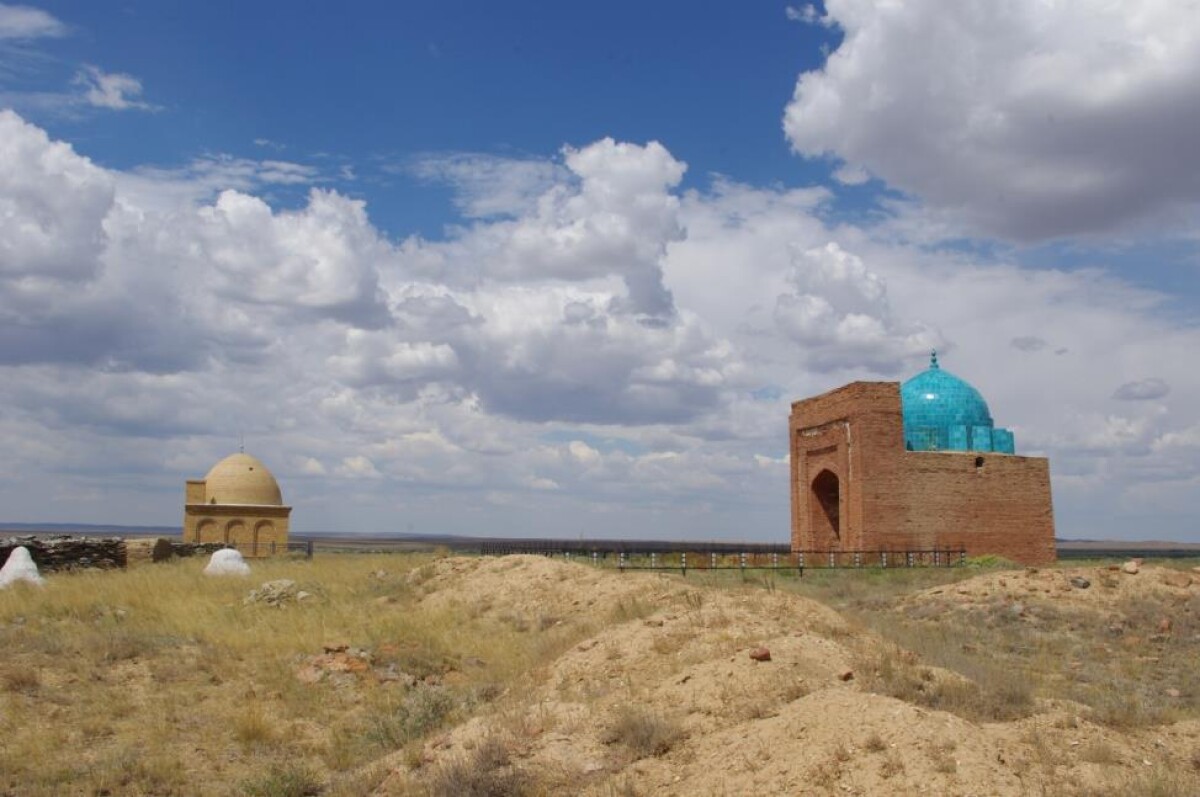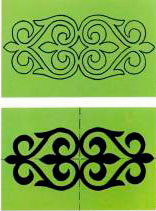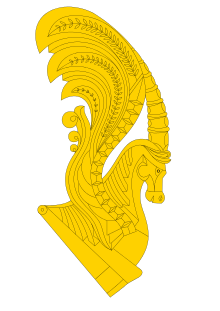
Some objects of the material world, as well as the phenomena of spiritual culture that are associated in the public consciousness with the history, the present and the future of particular peoples, countries and states, become the personification of the latter, making them recognizable symbols. For example, the Bayterek monument in Astana is a symbol of the revival of independent Kazakhstan. Apples of "Aport" are a symbol of Almaty. Competition (aytys) of akyns (singers-improvisers) is a symbol of oral creativity only among the Kazakhs. Such examples can be listed indefinitely, if you keep in mind the symbols in the historical context.
In the Kazakh steppe, the Ulytau Mountains rise. By geographical parameters it is the center of Kazakhstan. But this is not an ordinary natural object. According to folk legends, the Ulytau Mountains contain a deeper, more sacred meaning. On the mountain rises the mausoleum of Alasha-khan, which became a mythological symbol of the single source of Kazakh zhuz. According to legend, the mighty khan had a son Alasha (piebald), who later became a single khan of the three zhuz. And on the top of this mountain, he was ritually raised on a white koshma (felt) as a sign of his election as the khan. Since then Ulytau has become a sacred place of ascension to the khan's throne. In addition, according to legend, Ulytau took and guarded the peace of the great rulers of the steppe - Tokhtamysh Khan, Yedige Batyr, Emir Timur.
Visiting the sacred for all Kazakhstani Ulytau gave N.A. Nazarbayev food for thought. The first thing he thought about, not as the President of the country, but as an aksakal, who had accumulated a rich life experience, the youth must know their history. Otherwise, the people will be like an orphan, without a father and mother. And Ulytau is like an eternal book, pages of which our ancestors wrote on stone and rocks in the Bronze Age. Turks and Kypchaks built statehood, Kazakhs, as worthy descendants of formidable, unique nomadic civilizations, continued the history of their ancestors. Ulytau is a witness of the struggle of Kazakh zhuz for their land. Here the batyrs received spiritual strength and bata (blessing) and under the nine-paunch banner of the Kazakh khan Khak-Nazar defended every inch of the earth, sacrificing in this struggle their best sons. From there, in 1730, the Kazakh militsiya of the three zhuz came forward and defeated the Dzhungar army, and since then this place is called "Kalmak kyrylgan."
Paying tribute to Ulytau, which played an important role in the history of the people and the preservation of statehood, N.A. Nazarbayev, choosing a place for the future capital, specially visited Ulytau, but proceeding from the positions of the economy, he came to the conclusion that without the proper infrastructure, the construction of a new capital would require more funds. However, as a sacred land of the Kazakhs - this region will always remain the spiritual capital. There will be a center of tourism; people will come here to worship the memory of their great ancestors.

The ancient symbolism of the Kazakhs was preserved in totems, tamgas, decoration, and ornaments. Some of them have survived to the present day and symbolize the common-Kazakhstan values. So, for example, the ornament "koshkar muyyz" (horn of argali), applied to numerous products, ranging from household items to high-tech production, unmistakably indicates the country of their production - Kazakhstan.
Ornament koshkar muyyz makes it possible to distinguish the Kazakh flag from any other. Ornament carries the coded information about the people. Argali symbolizes the desire for prosperity and well-being. The Kazakh nomad never hid his wealth in the chest; it was calculated in the number of sheep in the flocks grazing in the rich high mountain pastures.
The unique tools of spiritual creativity - kobyz and dombra, accompanying the nomad throughout his life for centuries, became symbols of the people, committed to the musical reflection of the processes that were taking place. Simple in design, simple to handle, they have sounded in every nomadic family since ancient times, accompanied by music and happy and sad days. And now it is difficult to meet the Kazakh family, where these tools would not occupy a place of honor.
All these and many other symbols that personify the Kazakhs and their country Kazakhstan played the role of a unique identification mark. But many of them, especially tribal tamgas and totems, did not become national symbols. In certain historical periods, especially in the years of armed confrontation with external forces, some symbols, such as, for example, the battle cry "Alash" became common to all Kazakhs, mobilizing them to fight the enemy. The banner of the Kazakhs, as a symbol of the struggle for freedom, was proudly borne by Kenessary Khan, Amangeldy Imanov and others.
Meanwhile, their legal design in the modern sense, as a national symbol was not implemented. For example, the color of the flag and the drawing on it were determined by the preferences of the rulers, respectively, specifically the historical conditions. For example, the white flag of Attila and Abylay-khan. But in any case they were consonant with the idea of "Mangilik El", the essence of which consisted in the independent, prosperous development of the country on the way to eternity.
During the period of Kazakhstan's accession to the Russian Empire, the former importance of state symbols was significantly weakened, which is quite logical due to the disintegration of the Kazakh Khanate, followed by a brief rise in the political role of Zhuz, which were no longer state entities. The former symbols were used sporadically in periods of national liberation struggle. At the same time, national symbols, embodying the culture and way of life of the Kazakhs, were preserved. And the symbols reflecting the state-power aspects of public life were being squeezed out of everyday life.

And only after Kazakhstan was incorporated into the USSR they gain their state symbol, reflecting the need for an alliance of the working class and the peasantry (hammer and sickle) and following the course towards a bright, prosperous future communism, the construction of which began after the victory of the socialist revolution (the rising sun), and could be successful in uniting the proletarians of all countries (ribbons on the head). But this way was to pass through a socialist federation - the USSR, on the arms of which there were inscriptions of all the Union republics in their native languages.
State symbols of the Soviet period reflected the desire of the ideologists of communism to flourish the life of people on a global scale, which is consonant with the idea of "Mangilik El" in the understanding of Attila and Genghis Khan, who sought to lead the peoples to “Mangilik El” through the conquest of territories under their surveillance.
However, theoretically, that is, abstractly, the attractive idea of a communist paradise was not realized at the first attempt, either because of too long a path that the peoples had to go through, or because of deliberately unfit ways to achieve this goal.
All elements of state symbols are not accidental. Each of them carries a profound meaning. In a holistic understanding, we see that they are closely intertwined with the national idea of "Mangilik El".
A look at the modern state symbols of the Republic of Kazakhstan from the position of "Mangilik El" shows that they reflect the basic values of "Mangilik El".

Winged horses are tulpars, permanent companions of the nomadic Kazakh. Even in ancient times people depicted horses in rock carvings. They carry their master, like on wings, across the boundless steppe expanses of Kazakhstan. Horses are a symbol of wealth, prosperity, abundance and well-being. The idea of prosperity and wealth is supplemented by head, which are seen in the wings of horses.
There are not many elements on the national flag: the sun, the eagle and the ornament, they are all on a blue canvas symbolizing the Eternal blue sky. This is one of the oldest symbols. The eternal blue sky is first mentioned in the Turkic stelae. In addition, the blue sky symbolizes peace, tranquility, a peaceful sky overhead, a single hospitable people open to all. The sky is one for all, it can not be divided, and it can not be seized, taken away, or conquered. This is especially important to remember now, when contrary to expectations, in the twenty-first century, the division of Kazakhs by Kazakhs into three zhuz, which once played a positive political role, began to revive. But now it has taken on new forms. Sadly, democratic processes have triggered a mechanism of generic protectionism, tribal and territorial lobbies in the executive branch, in financial and commercial spheres. Modern tribal ideology is a dangerous form of intra-national disintegration and disorientation. To overcome generic stereotypes, there are necessary factors: a historically established national statehood, a unitary state structure, territorial integrity, and a centuries-old culture. This was written by N.A. Nazarbayev in 1993 in his book "Ideological consolidation of society as a condition for the progress of Kazakhstan."
Eagle or golden eagles are symbols of freedom, independence. The sun, according to the existing heraldic canons, symbolizes wealth and abundance.

Shanyrak is the most important element of the symbols of the state emblem of the Republic of Kazakhstan. For all nomadic Turkic peoples shanyrak symbolizes the home, the homeland. There is a deep meaning here - Kazakhstan is our common home. We are all his children. We must protect it, make it strong and pass it on to our children.
Uyk and kerege, elements of the yurt, are full of rich semantic content. The Kazakh people are divided into three zhuz, which in turn consist of a multitude of tribes and clans that, like the Uyks, keep a yurt arch. This historical symbolism applied to modern Kazakhstan can be interpreted as follows: the numerous ethnic groups of Kazakhstan as uyks keep the yurt arch. On their hands is our house. Each ethnic group does not by itself survive, will not resist the onslaught of a natural element or an insidious enemy. But united in one whole, as kerege, the people of Kazakhstan will be unbeatable. The only sure way to realize national interests is to equalize all peoples with the integrating role of the Kazakh nation. In this regard, the key ideological task was the preservation of interethnic harmony. The national policy in the country is aimed at ensuring that Kazakhstan's multi-ethnicity becomes a factor consolidating society. Inside the idea of consolidation of the Kazakh society N.A. Nazarbayev singles out the idea of strengthening intra-national unity, that is, inside the Kazakh people.
State symbols are the most important tools for consolidating the nation. This provision was taken into account by the developers of the Doctrine of the Unity of the People of Kazakhstan (2010). In it, a major role is given to the propagation of symbols of statehood, aimed at strengthening the sense of patriotism, respect for the culture and traditions of the people of Kazakhstan.
The spirit of patriotism contributes to the strengthening of any state, the consolidation of a society in which pride for its state reigns. Kazakhstanis should, from their childhood, educate patriotic spirit, respectful attitude to state symbols, revive state traditions.
The patriotic act "Mangilik El" was adopted in April 2016 at the XXIV session of the Assembly of People of Kazakhstan, which was held in Astana under the chairmanship of the President of the RK, the Chairman of the Assembly N.A. Nazarbayev.
Citizens of Kazakhstan, based on the highest interests of society and the state, bound by one destiny and historical memory on the ancient Kazakh land, being the successors of the glorious history and traditions of Dala Eli - the Great Transfigured Steppe country, having realized the dream of many generations about Independence and realizing their sacred duty to future Generations, the importance of peace and harmony, unity and cohesion, in the year of the 25th anniversary of Independence we are accepting this Patriotic act - Mangilik El. We proudly call ourselves citizens of Independent Kazakhstan - a strong and successful state. Citizens of Kazakhstan are united in their desire to create the Nation of the One Future - Mangilik El. At the heart of Mangilik El are simple, understandable and most valuable for each of us truths: the well-being of our families, hospitality and diligence, stability, security and unity, confidence in the future.
The Patriotic Act calls for the strengthening, storage and transfer from generation to generation of the seven unshakable foundations of Mangilik El: Mangilik El is Independence and Astana; Mangilik El is a nation-wide unity, peace and harmony; Mangilik El is a Secular State and High Spirituality; Mangilik El is a sustainable economic growth based on innovation; Мangilik El is the Society of General Labor; Mangilik El is a community of History, Culture and Language; Mangilik El is the National security and global participation of Kazakhstan in solving global and regional problems.
The political act calls to follow the sacred values of Mangilik El, proudly carry the heavenly banner of our Motherland, and raise it on new heights of achievements of our country. This is a reflection of the trepidation of the state symbols of the country, as symbols of Mangilik El. This is a conscious choice for the sake of future generations, prosperity and well-being of the people of Kazakhstan! Let our united nation be strong - Mangilik El! Let the eternal land of Kazakhstan be blessed - Uly Dala Eli!
Thus, in Kazakh heraldry, the essence of the national idea Mangilik El, which represents the history of the Kazakh people as the state-forming nation of the Republic of Kazakhstan - Kazakh Eli, is traced. Simultaneously, the history of modern Kazakhstan as a multinational state, strives for world recognition and occupation of its worthy place in the heraldic culture.
Kazakhstan heraldry, personifying the history of the past and the present, the history and culture of the Kazakh people, becomes a component of ideology, influences the formation of Kazakhstan's patriotism, acts as a factor consolidating society.
Translated by Raushan MAKHMETZHANOVA
